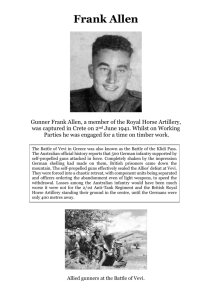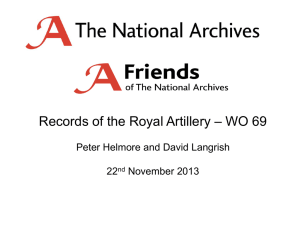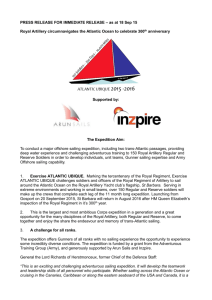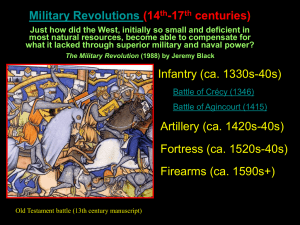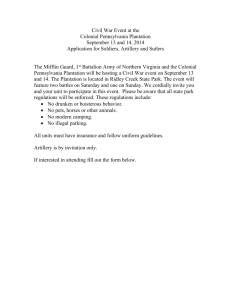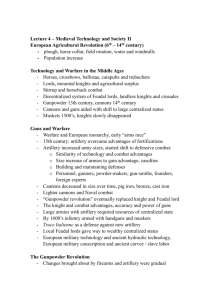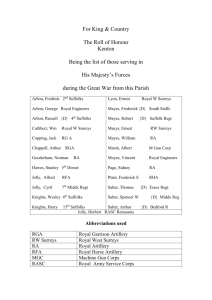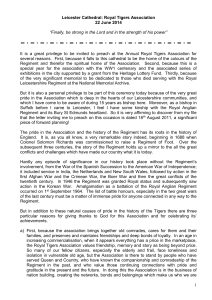The Battle Honour `UBIQUE` - 7fd-regt-raa
advertisement
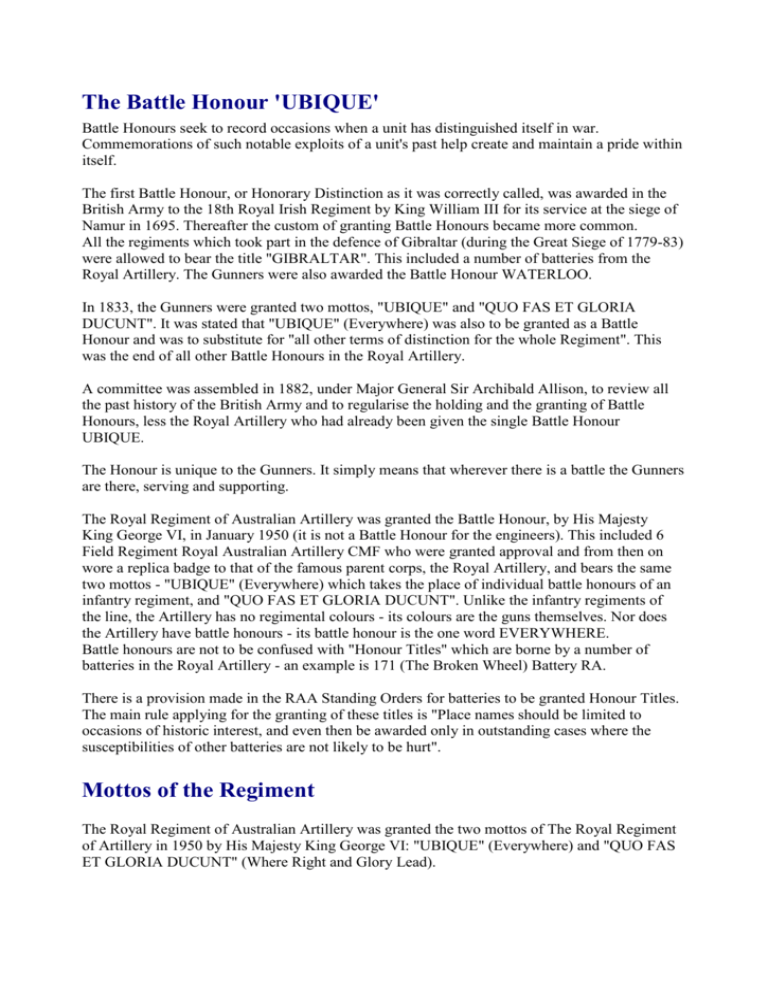
The Battle Honour 'UBIQUE' Battle Honours seek to record occasions when a unit has distinguished itself in war. Commemorations of such notable exploits of a unit's past help create and maintain a pride within itself. The first Battle Honour, or Honorary Distinction as it was correctly called, was awarded in the British Army to the 18th Royal Irish Regiment by King William III for its service at the siege of Namur in 1695. Thereafter the custom of granting Battle Honours became more common. All the regiments which took part in the defence of Gibraltar (during the Great Siege of 1779-83) were allowed to bear the title "GIBRALTAR". This included a number of batteries from the Royal Artillery. The Gunners were also awarded the Battle Honour WATERLOO. In 1833, the Gunners were granted two mottos, "UBIQUE" and "QUO FAS ET GLORIA DUCUNT". It was stated that "UBIQUE" (Everywhere) was also to be granted as a Battle Honour and was to substitute for "all other terms of distinction for the whole Regiment". This was the end of all other Battle Honours in the Royal Artillery. A committee was assembled in 1882, under Major General Sir Archibald Allison, to review all the past history of the British Army and to regularise the holding and the granting of Battle Honours, less the Royal Artillery who had already been given the single Battle Honour UBIQUE. The Honour is unique to the Gunners. It simply means that wherever there is a battle the Gunners are there, serving and supporting. The Royal Regiment of Australian Artillery was granted the Battle Honour, by His Majesty King George VI, in January 1950 (it is not a Battle Honour for the engineers). This included 6 Field Regiment Royal Australian Artillery CMF who were granted approval and from then on wore a replica badge to that of the famous parent corps, the Royal Artillery, and bears the same two mottos - "UBIQUE" (Everywhere) which takes the place of individual battle honours of an infantry regiment, and "QUO FAS ET GLORIA DUCUNT". Unlike the infantry regiments of the line, the Artillery has no regimental colours - its colours are the guns themselves. Nor does the Artillery have battle honours - its battle honour is the one word EVERYWHERE. Battle honours are not to be confused with "Honour Titles" which are borne by a number of batteries in the Royal Artillery - an example is 171 (The Broken Wheel) Battery RA. There is a provision made in the RAA Standing Orders for batteries to be granted Honour Titles. The main rule applying for the granting of these titles is "Place names should be limited to occasions of historic interest, and even then be awarded only in outstanding cases where the susceptibilities of other batteries are not likely to be hurt". Mottos of the Regiment The Royal Regiment of Australian Artillery was granted the two mottos of The Royal Regiment of Artillery in 1950 by His Majesty King George VI: "UBIQUE" (Everywhere) and "QUO FAS ET GLORIA DUCUNT" (Where Right and Glory Lead). The original motto of the NSW Artillery was "SEMPER FIDELIS" (Always Faithful). There is a line of thought that the motto in fact was "SEMPER PARATUS" (Always Ready) but this appears to be incorrect, even though 'A' Field Battery has adopted the latter. After Federation the motto was changed to "CONSENSU STABILES". There seems to be three opinions as to the translation: Strong in Agreement, Firm and Ready and, the most accepted, Firm and Steadfast. The Gunner motto used by Tasmanian Garrison Artillery was "PRO ARIS ET FOCIS" (For Fields and Hearths). Our Heritage The Royal Regiment of Australian Artillery (RAA) is very closely linked to the (British) Royal Regiment of Artillery (RA) . The history of the Royal Regiment of Artillery is the history of the British Army. Our motto is "Ubique" and on land, sea and air the Gunners have taken part in virtually every campaign and battle involving the Army since Crecy in 1346. In peacetime, guns were kept in Castles and were looked after by Master Gunners, skilled in their manufacture and so most knowledgeable in their use. In wartime, men were recruited and trained into a Trayne of Artillery, until on the 26th May 1716 the first two Companies of Artillery were formed by Royal Warrant at Woolwich. The Crimea, the Indian Mutiny, the Boer War, the two World Wars, the Falklands and the Gulf War were all fought by Gunners. We have produced Ten Field Marshals and the Victoria Cross has been won by Sixty-two members of the Regiment. It is a history of which we are very proud and a story worthy of the telling. The guns of the Royal Australian Artillery are the Regiment's Colours, in the same way as the flags and guidons of Infantry Regiments are theirs, leading them into battle. The Colours represent pride in the Regiment, so the guns are protected and retained at all costs. If the situation demands that they are left behind they must be disabled or destroyed. The gun depicted on the cap badge is a 9pdr Rifled Muzzle Loader of about 1871, and the rammer used to ram the charge into the muzzle is also seen, to the left of the carriage wheel. Ubique, surmounting the gun, means "Everywhere", and the Motto Quo Fas et Gloria Ducunt, "Where right and glory lead" Saint Barbara St. Barbara is the Patron Saint of The Royal Regiment of Artillery. Due to the manner of her death, St. Barbara is also traditionally the patron of armourers, gunsmiths, artillerymen, miners and anyone else who worked with cannon and explosives. She is invoked against thunder and lightning and all accidents arising from explosions of gunpowder. Barbara (later St Barbara) lived in the 4th century and was brought up as a heathen. A tyrannical father, Dioscorus, had kept her jealously secluded in a lonely tower which he had built for that purpose. Here, in her forced solitude, she gave herself to prayer and study, and contrived to receive instruction and Baptism in secret by a Christian priest. Barbara resisted her father's wish that she marry. Then on one occasion, during her father's absence, Barbara had three windows inserted into a bathhouse her father was constructing. Her purpose was thereby to honour the Trinity. Dioscorus was enraged by her action and by her conversion. So he himself denounced her before the civil tribunal. She was horribly tortured, and at last was beheaded. Her own father, merciless to the last, acted as her executioner. God, however, speedily punished her persecutors. While her soul was being borne by angels to Paradise, a flash of lightning struck Dioscorus, and he was hurried before the judgment seat of God. The Artillery Tie The Regimental Tie is a zigzag red line on a blue background. The line represents the lightning which, according to legend, killed Dioscorus in retribution for beheading his daughter Barbara for refusing to marry a heathen suitor. Before her death she turned to Christianity and was later canonized. In the early ages St Barbara was frequently invoked to grant safety during thunderstorms and on the advent of artillery, became the Patron Saint of Gunners
